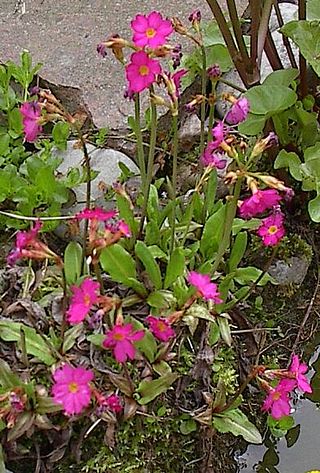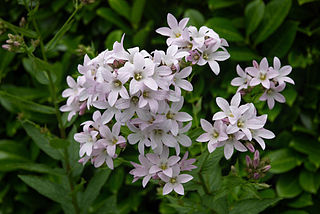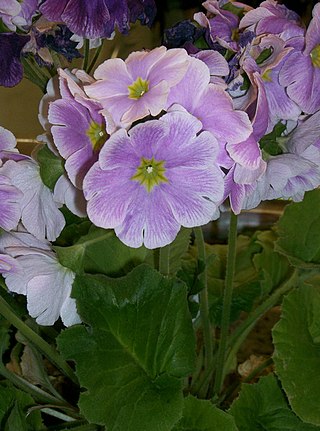
Primula is a genus of herbaceous flowering plants in the family Primulaceae. They include the primrose, a familiar wildflower of banks and verges. Other common species are P. auricula (auricula), P. veris (cowslip), and P. elatior (oxlip). These species and many others are valued for their ornamental flowers. They have been extensively cultivated and hybridised. Primula are native to the temperate Northern Hemisphere, south into tropical mountains in Ethiopia, Indonesia, and New Guinea, and in temperate southern South America. Almost half of the known species are from the Himalayas.

Pinus parviflora, also known as five-needle pine, Ulleungdo white pine, or Japanese white pine, is a pine in the white pine group, Pinus subgenus Strobus, native to Korea and Japan.

Primula bulleyana is a species of flowering plant in the family Primulaceae, native to hillsides in China.

Primula vulgaris, the common primrose, is a species of flowering plant in the family Primulaceae, native to western and southern Europe, northwest Africa, and parts of southwest Asia. The common name is primrose, or occasionally common primrose or English primrose to distinguish it from other Primula species also called primroses. None of these are closely related to the evening primroses.

Erica vagans, the Cornish heath or wandering heath, is a species of flowering plant in the family Ericaceae, native to Ireland, Cornwall, western France and Spain. It is a vigorous, spreading, evergreen heather reaching 75 cm (30 in) tall and wide, with pink flowers borne in racemes 14 cm (6 in) long in summer and autumn. The Latin specific epithet vagans literally means "wandering"; in this context it means "widely distributed".

Primula auricula, often known as auricula, mountain cowslip or bear's ear, is a species of flowering plant in the family Primulaceae, that grows on basic rocks in the mountain ranges of central Europe, including the western Alps, Jura Mountains, the Vosges, the Black Forest and the Tatra Mountains.

Primula florindae, the Tibetan cowslip or giant cowslip, is a species of flowering plant in the family Primulaceae, native to southeastern Tibet, where it grows in huge numbers close to rivers such as the Tsangpo. It is a substantial herbaceous perennial growing to 120 cm (47 in) tall by 90 cm (35 in) wide. In summer the flower stalks rise from basal rosettes of 5–20 cm (2–8 in) long leaves. They bear clusters of 20–40 yellow, pendent, bell-like, delicately scented flowers with a mealy white bloom.

Primula elatior, the oxlip, is a species of flowering plant in the family Primulaceae, native to nutrient-poor and calcium-rich damp woods and meadows throughout Europe, with northern borders in Denmark and southern parts of Sweden, eastwards to the Altai Mountains and on the Kola Peninsula in Russia, and westwards in the British Isles.

Thymus vulgaris is a species of flowering plant in the mint family Lamiaceae, native to southern Europe from the western Mediterranean to southern Italy. Growing to 15–30 cm (6–12 in) tall by 40 cm (16 in) wide, it is a bushy, woody-based evergreen subshrub with small, highly aromatic, grey-green leaves and clusters of purple or pink flowers in early summer.

Dracaena reflexa is a tree native to Mozambique, Madagascar, Mauritius, and other nearby islands of the Indian Ocean. It is widely grown as an ornamental plant and houseplant, valued for its richly coloured, evergreen leaves, and thick, irregular stems.

Primula denticulata, the drumstick primula, is a species of flowering plant in the family Primulaceae, native to moist alpine regions of China, Afghanistan, Bhutan, India, Kashmir, N Myanmar, Nepal, and Pakistan. It is an herbaceous perennial growing to 45 cm (18 in) tall and wide, with rosettes of oval leaves and sturdy stems bearing spherical umbels of purple flowers in late spring and early summer. Flowers can also be lavender, pink, or white in colour.

Primula rosea, the rosy primrose, is a flowering plant species in the genus Primula, native to the Himalayas. Growing to 50 cm (20 in) tall, it is a hardy herbaceous perennial with red-tinged leaves and clumps of rich pink flowers in spring.

Campanula lactiflora, the milky bellflower, is a species of flowering plant in the genus Campanula of the family Campanulaceae, native to Turkey and the Caucasus. It is a medium-sized herbaceous perennial growing to 1.2 m, with narrow, toothed leaves 5–12 cm (2–5 in) long. Large conical clusters of open, star-shaped flowers are produced on branching stems in summer. In favourable conditions it will self-seed with variable results. The flowers are usually white or pale blue, but numerous cultivars have been developed for garden use, in a range of colours.

Primula sikkimensis is a species of flowering plant in the family Primulaceae, native to the Himalayan region at altitudes of 3,200–4,400 m (10,499–14,436 ft), from western Nepal to south west China. It is an herbaceous perennial growing to 90 cm (35 in) tall by 60 cm (24 in) broad, with umbels of fragrant yellow flowers, appearing in summer on slender stems which arise from basal rosettes of leaves. The flowers may be covered by a mealy-white layer (farina).

Primula japonica, the Japanese primrose, Japanese cowslip, Queen of primroses, or valley red, is a species of flowering plant in the family Primulaceae, native to Japan. The common name Japanese primrose also applies to the related species Primula sieboldii.

Primula obconica is a species of flowering plant in the family Primulaceae, native to China. It is a short-lived evergreen perennial growing to 40 cm (16 in) tall by 25 cm (10 in) broad, with rosettes of coarse, heart-shaped leaves, and thick stalks bearing umbels of lavender flowers in late winter and early spring.

Primula pulverulenta, the mealy primrose or mealy cowslip, is a species of flowering plant in the family Primulaceae, native to damp habitats in China. It is a herbaceous perennial growing to 100 cm (39 in) tall by 60 cm (24 in) broad, with strong stems of deep pink flowers arising from basal rosettes of leaves in early summer. The flowers are grouped at intervals along the stem in a tiered formation, hence the common name "candelabra primula" which is often applied to this and other species with a similar arrangement.

Primula prolifera, the candelabra primrose or glory of the bog, is a flowering plant in the family Primulaceae. Its botanical name is currently unresolved.

Primula frondosa, the leafy primrose, is a species of flowering plant in the family Primulaceae, native to the Balkans. It inhabits shady spots in a small region of the central Balkan Mountains range in Bulgaria, where it is found at altitudes from 800 to 2,200 m. Its populations are situated within the boundaries of the Central Balkan National Park and the nature reserves Sokolna, Dzhendema and Stara Reka.

Primula capitata, commonly known as the round-headed Himalayan primrose or Asiatic primrose is a species of flowering plant in the family Primulaceae. It is a short-lived perennial, forming semi-evergreen rosettes of 15cm pale green, mealy leaves that are finely toothed, oblong-lance-shaped or inversely lance-shaped, with white-mealy undersides. Its flowers are up to 1cm long, dark purple and tubular, with shallowly lobed petals; they are borne in racemes that form flattened spheres, held on white-mealy stems about 40cm high.



















